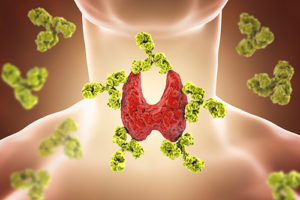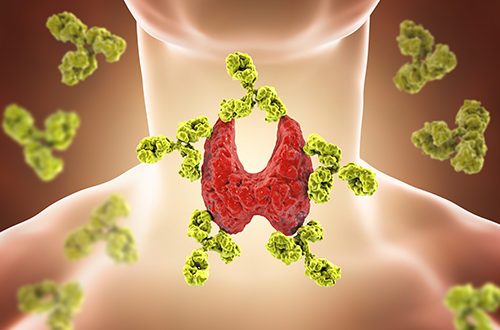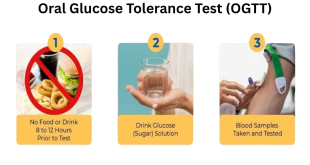 Thyroid dysfunction, along with a higher than average prevalence of goiter, is one of the major public health problems among the local population. It has been estimated that 0.2% of the deaths in Nepal result from endocrine disorders, among which thyroid disorders is a major one. Thyroid disorders can range from a small, harmless goiter (enlarged gland) to life-threatening cancer. The most common thyroid problems involve an abnormal production of thyroid hormones. Too little production of these hormones results in a condition known as hypothyroidism, while too much leads to hyperthyroidism. Although the symptoms of thyroid disorders are unpleasant or uncomfortable, most thyroid conditions can be managed well if properly diagnosed and treated.
Thyroid dysfunction, along with a higher than average prevalence of goiter, is one of the major public health problems among the local population. It has been estimated that 0.2% of the deaths in Nepal result from endocrine disorders, among which thyroid disorders is a major one. Thyroid disorders can range from a small, harmless goiter (enlarged gland) to life-threatening cancer. The most common thyroid problems involve an abnormal production of thyroid hormones. Too little production of these hormones results in a condition known as hypothyroidism, while too much leads to hyperthyroidism. Although the symptoms of thyroid disorders are unpleasant or uncomfortable, most thyroid conditions can be managed well if properly diagnosed and treated.
Thyroid gland is an endocrine gland located at the front of the neck, below the Adam’s apple. It has two lobes that are connected by the thyroid isthmus, a narrow band of thyroid tissue. Microscopically, the functional unit of the thyroid gland is the spherical thyroid follicle, lined with follicular cells and occasional parafollicular cells that surround a lumen containing colloid. The thyroid gland secretes three hormones: the two hormones: triiodothyronine (T3) and thyroxine (T4), and a peptide hormone, calcitonin. Calcitonin plays a role in calcium homeostasis. Secretion of the two thyroid hormones is regulated by thyroid stimulating hormone (TSH) which is secreted from the anterior pituitary gland. TSH is regulated by thyrotropin releasing hormone, which is produced by the hypothalamus.
The major thyroid hormone secreted by the thyroid gland is thyroxine, also called T4 because it contains four iodine atoms. T4 is converted to triiodothyronine (T3) by the removal of an iodine atom. This occurs mainly in the liver and in certain tissues where T3 acts, such as in the brain. The amount of TSH that the pituitary sends into the bloodstream depends on the amount of T4 that the pituitary sees. If the pituitary sees very little T4, then it produces more TSH to tell the thyroid gland to produce more T4. Once the T4 in the bloodstream goes above a certain level, the pituitary’s production of TSH is shut off. In fact, the thyroid and pituitary act in many ways like a heater and a thermostat.
The thyroid hormones increase the basal metabolic rate and have effects on almost all body tissues. They increase the rate of breathing, intake and consumption of oxygen, and increase the activity of mitochondria. These factors increase blood flow and the body’s temperature. Thyroid hormones are essential for normal development as they increase the growth rate of young people. These play a crucial role in brain maturation, especially during fetal development and first few years of postnatal life. After secretion, only a very small proportion of the thyroid hormones travel freely in the blood. Most are bound thyroxine binding globulin (about 70%), transthyretin (10%), and albumin (15%). Only the 0.03% of T4 and 0.3% of T3 traveling freely have hormonal activity. In addition, up to 85% of the T3 in blood is produced following conversion from T4 by iodothyronine deiodinases in organs around the body.
Hypothyroidism: It stems from an underproduction of thyroid hormones. Since the body’s energy production requires thyroid hormones, a drop in hormone production leads to lower energy levels, causing you to feel weak and tired. Approximately 25 million people suffer with hypothyroidism, and about half are undiagnosed. Older adults, particularly women, are more likely to develop hypothyroidism than younger adults. When hypothyroidism is left untreated, it can raise cholesterol levels, increasing the risk of a heart attack or stroke. During pregnancy, untreated hypothyroidism can cause mental retardation in the baby.
Causes of hypothyroidism may include:
Hashimoto’s thyroiditis: This is an autoimmune disorder in which the thyroid gland is infiltrated by the lymphocytes B cell and T cells and these progressively destroy the thyroid gland. Hashimoto’s is more common in females than males, much more common after the age of 60, and has known genetic risk factors. Also more common in individuals with Hashimoto’s thyroiditis are type I diabetes, pernicious anemia, Addison’s disease, and vitiligo.
Removal of the thyroid gland:
The thyroid may be surgically removed or chemically destroyed in the treatment for hyperthyroidism.
Drugs: The drugs that are given intentionally to decrease thyroid secretion (like methimazole and propylthiouracil) can cause hypothyroidism. Drugs used to treat non thyroid conditions like amiodarone andlithiumcan cause hypothyroidism.
Iodine: Both iodine deficiency and excess can cause hypothyroidism. Iodine deficiency is the most common cause of hypothyroidism (and goiter) worldwide. The use of iodized salt to add iodine to the diet has eliminated endemic cretinism in most developed countries, and over 120 countries have made the iodination of salt mandatory. Despite mandatory iodination of salt, iodine deficiency is still prevalent in the Himalayan, sub- Himalayan, and Terai regions of Nepal. Contrastingly, iodine excess also can cause hypothyroidism, as it inhibits iodide organification and T4 and T3 synthesis. Patients at risk for iodine-induced hypothyroidism include those with chronic autoimmune thyroiditis and those who have had a partial thyroidectomy or a history of radioiodine therapy, painless, postpartum, or subacute granulomatous thyroiditis.
A non-functioning thyroid gland: Sometimes, the thyroid gland doesn’t work correctly from birth. This affects about 1 in 4,000 newborns. If left untreated, the child could have both physical and mental issues in the future. All newborns are given a screening blood test in the hospital to check their thyroid function.
Hyperthyroidism: It results when the thyroid gland becomes overactive. Hyperthyroidism affects women five times to 10 times more often than men, and is most common in people younger than 40. People with hyperthyroidism have problems that reflect over activity of the body’s organs, resulting in such symptoms as sweating, feeling hot, rapid heartbeat, weight loss and sometimes eye problems.
Hyperthyroidism can occur in several ways:
Graves’ disease: It is an autoimmune disorder that is the most common cause of hyperthyroidism. In Graves’ disease, for an unknown reason autoantibodies develop against the thyroid stimulating hormone receptor. These antibodies activate the receptor, leading to development of a goiter and symptoms of hyperthyroidism, such as heat intolerance, weight loss, diarrhea, and palpitations. Occasionally, such antibodies block but do not activate the receptor, leading to symptoms associated with hypothyroidism.
Toxic adenomas: Nodules (abnormal growths or lumps) develop in the thyroid gland and begin to secrete thyroid hormones, upsetting the body’s chemical balance. Some goiters may contain several of these nodules.
Subacute thyroiditis: Painful inflammation of the thyroid causes the gland to enlarge and “leak” excess hormones, resulting in temporary hyperthyroidism, which resolves spontaneously. Subacute thyroiditis generally lasts a few weeks, but may persist for months.
Pituitary gland malfunctions or cancerous growths in the thyroid gland: Although rare, hyperthyroidism can also develop from these causes.
Silent thyroiditis: This is usually a temporary state of excess thyroid hormone release causing mild hyperthyroidism. In some cases, it can result in permanent damage to the thyroid hormone production by the gland.
Postpartum thyroiditis: This is a type of hyperthyroidism that occurs in a small percentage of women within months of delivery. The course of the illness takes place over several months, and is characterized by a painless goiter. Antibodies against thyroid peroxidase can be found on testing.The inflammation usually resolves without treatment, although thyroid hormone replacement may be needed during the period of hypothyroidism. Typically, these women fully recover normal thyroid function.
Ingestion of excess thyroid hormones can also result in hyperthyroidism.
How Is Hypothyroidism or Hyperthyroidism Diagnosed?
Symptoms of an overactive thyroid (hyperthyroidism) can include:
• Experiencing anxiety, irritability, and nervousness.
• Having trouble sleeping.
• Losing weight.
• Having an enlarged thyroid gland or a goiter.
• Having muscle weakness and tremors.
• Experiencing irregular menstrual periods or having your menstrual cycle stop.
• Feeling sensitive to heat.
• Having vision problems or eye irritation.
Symptoms of an underactive thyroid (hypothyroidism) can include:
• Feeling tired (fatigue).
• Gaining weight.
• Experiencing forgetfulness.
• Having frequent and heavy menstrual periods.
• Having dry and coarse hair.
• Having a hoarse voice.
• Experiencing intolerance to cold temperatures.
Blood tests to measure these hormones are readily available and widely used, but not all are useful in all situations. Tests to evaluate thyroid function include the following:
TSH Tests
The best way to initially test thyroid function is to measure the TSH level in a blood sample. Changes in TSH can serve as an “early warning system”—often occurring before the actual level of thyroid hormones in the body becomes too high or too low. A high TSH level indicates that the thyroid gland is not making enough thyroid hormone (primary hypothyroidism). The opposite situation, in which the TSH level is low, usually indicates that the thyroid is producing too much thyroid hormone (hyperthyroidism). Occasionally, a low TSH may result from an abnormality in the pituitary gland, which prevents it from making enough TSH to stimulate the thyroid (secondary hypothyroidism). In most healthy individuals, a normal TSH value means that the thyroid is functioning properly.
T4 Tests
T4 is the main form of thyroid hormone circulating in the blood. A Total T4 measures the bound and free hormone and can change when binding proteins differ. A Free T4 measures what is not bound and able to enter and affect the body tissues. Tests measuring free T4—either a free T4 (FT4) or free T4 index (FTI)—more accurately reflect how the thyroid gland is functioning when checked with a TSH. The finding of an elevated TSH and low FT4 or FTI indicates primary hypothyroidism due to disease in the thyroid gland. A low TSH and low FT4 or FTI indicates hypothyroidism due to a problem involving the pituitary gland. A low TSH with an elevated FT4 or FTI is found in individuals who have hyperthyroidism.
T3 Tests
T3 tests are often useful for the diagnosis of hyperthyroidism or to determine the severity of hyperthyroidism. Patients who are hyperthyroid will have an elevated T3 level. In some individuals with a low TSH, only the T3 is elevated, and the FT4 or FTI is normal. T3 testing rarely is helpful in the hypothyroid patient, since it is the last test to become abnormal. Patients can be severely hypothyroid with a high TSH and low FT4 or FTI, but have a normal T3.
Thyroid Antibody tests
The immune system of the body normally protects us from foreign invaders, such as bacteria and viruses, by destroying them with substances called antibodies produced by blood cells, known as lymphocytes. In many patients with hypothyroidism or hyperthyroidism, lymphocytes react against the thyroid (thyroid autoimmunity) and make antibodies against thyroid cell proteins. Two common antibodies are thyroid peroxidase antibody and thyroglobulin antibody. Measuring levels of thyroid antibodies may help diagnose the cause of the thyroid problem. For example, positive anti-thyroid peroxidase and/or anti-thyroglobulin antibodies in a patient with hypothyroidism result in a diagnosis of Hashimoto’s thyroiditis. While detecting antibodies is helpful in the initial diagnosis of hypothyroidism due to autoimmune thyroiditis, following their levels over time is not helpful in detecting the development of hypothyroidism or response to therapy.
A different antibody that may be positive in a patient with hyperthyroidism is the stimulatory TSH receptor antibody (TSI). This antibody causes the thyroid to be overactive. If you have Graves’ disease, your doctor might also order a thyrotropin receptor antibody test (TSHR or TRAb), which detects both stimulating and blocking antibodies. Following antibody levels in Graves’ patients may help to assess response to treatment of hyperthyroidism, to determine when it is appropriate to discontinue antithyroid medication, and to assess the risk of passing antibodies to the fetus during pregnancy.
Thyroglobulin
Thyroglobulin (Tg) is a protein produced by normal thyroid cells and thyroid cancer cells. It is not a measure of thyroid function, and it does not diagnose thyroid cancer when the thyroid gland is still present. It is used most often in patients who have had surgery for thyroid cancer in order to monitor them after treatment. Although measured frequently in certain scenarios and individuals, Tg is not a primary measure of thyroid hormone function.
Thyroid disease treatment:
If you have high levels of thyroid hormones (hyperthyroidism), treatment options can include: anti-thyroid drugs (methimazole and propylthioracil). These are medications that stop your thyroid from making hormones.
If you have low levels of thyroid hormones (hypothyroidism), the main treatment option is thyroid replacement medications.
What are Goitrogens?
Goitrogens are compounds that interfere with the normal function of the thyroid gland. The link between goitrogens and thyroid function was first described in 1928, when scientists observed thyroid gland enlargement in rabbits eating fresh cabbage. This discovery led to the hypothesis that substances in some vegetables may affect thyroid function when consumed in excess. Goitrins, thiocyanates, and flavonoids are the three most common types of goitrogens. For people with thyroid problems, high intake of goitrogens can worsen thyroid function by:
• Blocking iodine: Goitrogens may prevent iodine from entering the thyroid gland, which is needed to produce thyroid hormones.
• Interfering with TPO: The thyroid peroxidase (TPO) enzyme attaches iodine to the amino acid tyrosine, which together form the basis of thyroid hormones.
• Reducing TSH: Goitrogens may interfere with thyroid stimulating hormone (TSH), which helps the thyroid gland produce hormones.
Goitrogens can reduce the thyroid’s ability to produce the hormones your body needs to function normally. They are more likely to negatively impact people who already have poor thyroid function. Goitrogens are found in a wide variety of cruciferous vegetables, fruits, starchy plants, and soy-based foods like broccoli, cabbage, cauliflower, spinach, turnips, kale, sweet potatoes, etc. A varied diet, cooking vegetables, avoiding smoking, and getting your fill of iodine and selenium are simple ways to limit the effects of goitrogens.
 Medicosnext
Medicosnext



